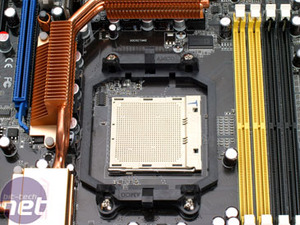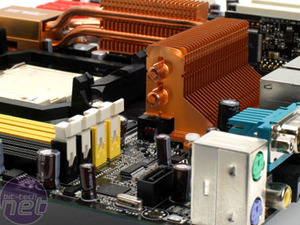
The northbridge and southbridge, as well as the voltage regulators for the CPU are cooled by an inventive passive system of copper heatpipes. This not only keeps the board silent, it moves the heat towards the CPU fan to push air over instead of relying on tiny fans with poor air flow to cool the chipsets. The dual heatpipe system is a prominent part of the motherboard and it looks great as it snakes across the board.


Working around from the left edge, there are four vertically aligned DDR2 memory slots denoting module installation by colour: two modules should either be installed in the yellow or black slots to enable dual channel mode. To the left is the AM2 socket which is generally kept clear, however it is close the large copper fins and northbridge block of the heatpipe cooler which covers the 8 phase power regulation to provide silky smooth electrical currents for your CPU.


Moving down the bottom edge, the BIOS battery is located next to the northbridge portion of the impressive heatpipe array. Below the southbridge there are six red SATA2 ports controlled by the nForce 590 SLI disk controller. Unfortunately the bottom two are unusable if you install a pair of high end video cards for some SLI action - this is a bit of an oversight in our opinion, almost as if ASUS hasn’t taken this usage model into account.

MSI MPG Velox 100R Chassis Review
October 14 2021 | 15:04







Want to comment? Please log in.